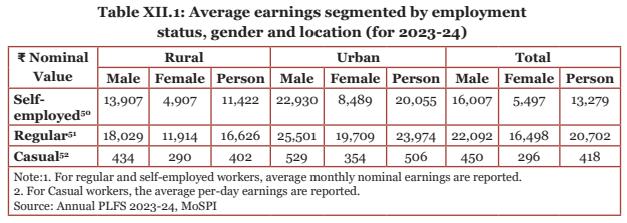Viplav Kumar
In 2023-24, the total size of India’s labour force was approximately 60 crore including male, female, rural, urban, regular salaried employees, self-employed people and casual workers in India. On an average, the poorest 27.5 percent of the labour force earned less than Rs.100 a day, half of the labourforce earned less than Rs.300 a day or Rs.9000 per month, and less than one-fourth of the labourforce could manage to earn more than Rs.500 a day or Rs.15000 per month.
The Economic Survey of 2024-25 states that the average monthly income of self-employed people was Rs.13,279, that of the regular salaried employees Rs.20,702 and that of the casual labourers Rs.418 a day or approximately Rs.12,750 per month in 2023-24 as per the Periodic Labour Force Survey (PLFS). The average earnings are much less for the female labour force (see table) and the average earnings are relatively less in the rural areas as compared to the urban areas.

Source: PP.378, Economic Survey 2024-25, Ministry of Finance, Government of India.
Despite some increase in the nominal average income of both male and female workforce since 2018-19 till 2023-24 (excepting the female self-employed workers), the real earnings (at constant prices) are yet to reach the 2017-18 level, excepting the casual workers. The average monthly earning of the female self-employed workers has fallen even in nominal terms from Rs.5,935 in 2017-18 to Rs.5,497 in 2023-24, the Economic Survey 2024-25 says. There has been some improvement in the real wages of both male and female casual labourers.
An independent analysis of the unit level PLFS data reveals that only the top 22% of the Indian labour force earned more than Rs. 15,000 per month or Rs.500 a day and the bottom 27.5 percent labour force earned less than Rs.3000 per month or less than Rs.100 a day in India in 2023-24 (Das & Mishra, Outlook-Business, 30th January 2025). The median earning is near Rs.9,000 per month or Rs.300 a day, which is equivalent to the MGNREGS average wage rate in the country. This largest government survey on the employment-unemployment situation in the country (PLFS) also reveals that 46 percent of rural male and 24 percent of urban male labour force, including regular salaried employees, casual labourers and self-employed people, earned less than Rs.300 a day. As high as 91% of rural female and 64% of urban female labour force earned less than Rs.9,000 per month, on an average, in 2023-24.
As far as the rural wages are concerned, the Economic Survey 2024-25 has shown that there has been zero percent growth in rural non-farm wage rates and less than 2 percent annual growth in agricultural wages since lockdown. Based on the Labour Bureau monthly data on wages, it is shown that the nominal growth rate in rural wages has been around 6 percent per annum and the inflation rate has also been around that – leaving the real wage rate more or less unchanged between May 2021 and September 2024. Interestingly, the real GDP (at constant 2011-12 prices) of the country increased at a rate of more than 6 percent per annum during this period.
If we look at the income tax return statistics from the Central Board of Direct Taxes (CBDT), the total number of people filing income tax return in 2023-24 was around 8 crores. Within that little above 4 crore people could earn more than Rs.5 lakh per annum. It is mentioned that additional 2.35 crore people have paid income tax in 2023-24 but, yet to file their return. If we assume that all of them have earned more than Rs.5 lakh, then the total number of people earning more than Rs.5 lakh would become 6.45 crore. According to the periodic labour force survey (PLFS) data of 2023-24, the estimated size of Indian labourforce was around 60 crores, assuming the population of the country to be 143.5 crore in 2023-24. Therefore, only 10.75 percent of labour force in India could earn more than Rs.5 lakh in 2023-24. There could be more than one earning members in some families. Hence, only the top 10% of the households comes under the bracket of direct taxation and the others do not earn enough to pay direct tax in India. Nonetheless, we may still call this income class to be the ‘middle class’ in sociological sense. However, the estimated monthly income of the average (median) household will be less than Rs.10,000 today (in 2025) in our country.
